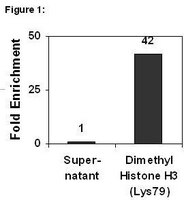17-10125 Sigma-AldrichChIPAb+™ Dimethyl-Histone H3 (Lys79) - ChIP Validated Antibody and Primer Set, rabbit monoclonal
This ChIPAb+ Dimethyl-Histone H3 (Lys79) -ChIP Validated Antibody & Primer Set conveniently includes the antibody & the specific control PCR primers.
More>> This ChIPAb+ Dimethyl-Histone H3 (Lys79) -ChIP Validated Antibody & Primer Set conveniently includes the antibody & the specific control PCR primers. Less<<Recommended Products
Overview
| Replacement Information |
|---|
Key Specifications Table
| Species Reactivity | Key Applications |
|---|---|
| H, Vrt | WB, ChIP |
| References |
|---|
| Product Information | |
|---|---|
| Format | Culture Supernatant |
| Control |
|
| Presentation | Anti-Dimethyl-Histone H3 (Lys79) (rabbit Monoclonal), Part No. CS204341. One vial containing 100 µL of cultured supernantant in 0.05% sodium azide. Store at -20°C. Negative Control Supernatant, Part No. CS200567. One vial containing 100 µL of cultured supernatant in 0.05% sodium azide. Store at -20°C. Control Primers, Part No. 22-004. One vial containing 75 μL of 5 μM of each primer specific for human GAPDH. Store at -20°C. FOR: TAC TAG CGG TTT TAC GGG CG REV: TCG AAC AGG AGG AGC AGA GAG CGA |
| Quality Level | MQ100 |
| Physicochemical Information |
|---|
| Dimensions |
|---|
| Materials Information |
|---|
| Toxicological Information |
|---|
| Safety Information according to GHS |
|---|
| Safety Information |
|---|
| Packaging Information | |
|---|---|
| Material Size | 25 assays |
| Material Package | 25 assays per set. Recommended use: ~4 μL of antibody per chromatin immunoprecipitation (dependent upon biological context). |
| Transport Information |
|---|
| Supplemental Information |
|---|
| Specifications |
|---|
| Global Trade Item Number | |
|---|---|
| Catalog Number | GTIN |
| 17-10125 | 04053252376535 |
Documentation
ChIPAb+™ Dimethyl-Histone H3 (Lys79) - ChIP Validated Antibody and Primer Set, rabbit monoclonal SDS
| Title |
|---|
ChIPAb+™ Dimethyl-Histone H3 (Lys79) - ChIP Validated Antibody and Primer Set, rabbit monoclonal Certificates of Analysis
| Title | Lot Number |
|---|---|
| ChIPAb+ Dimethyl-Histone H3 (Lys79) - 2030044 | 2030044 |
| ChIPAb+ Dimethyl-Histone H3 (Lys79) - NRG1804154 | NRG1804154 |
| ChIPAb+ Dimethyl-Histone H3 (Lys79) - 2490689 | 2490689 |
| ChIPAb+ Dimethyl-Histone H3 (Lys79) Monoclonal Antibody/ Primer Set | 3123032 |
Brochure
| Title |
|---|
| Advance your Epigenetics Research |












